A New Terminal.
A New Chapter.
A New HVN.
We’re building the future: designed with you in mind.
Tweed-New Haven Airport (HVN) is undertaking a major capital improvement project with a new 84,000-square-foot terminal and extended runway—a project that will support thousands of local jobs, strengthen the regional economy, and unlock new opportunities with every destination.
As of Summer 2025, the new terminal has reached 60% Design—a key milestone in layout development, systems planning, and architectural design. While many core elements are in place, the design remains subject to change as we refine details and incorporate feedback on the path to final design.
Take a closer look and learn more about how we’re delivering a more modern, efficient, and convenient airport for Southern Connecticut.




4700+
Local jobs created by 2030
$144M+
Statewide economic impact by 2027
$368M+
New Haven County economic impact by 2027
Source: Tweed-New Haven Airport Economic Impact Analysis (UConn Center for Economic Analysis, May 2025)
The HVN Connection
See what’s taking off at HVN in the latest edition of our newsletter, The HVN Connection – delivered straight to your inbox.

HVN is building for the future—pairing major infrastructure investments with a long-term commitment to environmental sustainability.

CT DEEP Inland & Wetland Permit Application (2025)
Tweed-New Haven Airport, in partnership with Tweed-New Haven Airport Authority (TNHAA) and the New HVN LLC, is moving forward with a transformational project. This expansion will allow us to better serve the region, while also protecting the environment and strengthening our local economy through the construction of a new, 84,000 square foot terminal and longer runway.
Project Overview
The project extends Runway 02-20 by 639 feet to the south and 336 feet to the north, resulting in a total length of 6,575 feet. A new 84,000-square-foot East Terminal, expanded parking for up to 4,000 vehicles, and a dedicated access road from Proto Drive will be built entirely within the existing airport footprint, minimizing land use and environmental impacts.
Modernization of critical infrastructure to meet regional air service demand
The runway extension and terminal expansion will allow HVN to accommodate larger aircraft and increased passenger volumes, providing the region with more reliable air service and new destinations. The improvements will support the airport’s projected growth through 2040 and beyond.
Major increase in operational and fuel efficiencies
Extending the runway removes current aircraft payload restrictions, allowing airlines to operate more efficiently. Apron and taxiway improvements will reduce fuel burn and greenhouse gas emissions by shortening taxi times.
Enhanced flood resilience designed for extreme climate conditions
The East Terminal will be elevated on structural piers above the 100-year flood elevation. Key systems will be placed above flood levels, and the structure will allow water to pass underneath during severe weather events.
Restoration of native tidal wetlands and habitat expansion
The environmental mitigation plan will enhance or create over 32 acres of high-value tidal wetlands, improving water quality, supporting estuarine wildlife, and serving as a natural coastal defense.
Prioritizes community compatibility by routing airport traffic through commercial and industrial areas, avoiding residential neighborhoods
The expansion prioritizes compatibility with surrounding neighborhoods through smart design and strategic planning. A new access road will route airport traffic through commercial and industrial corridors, avoiding residential streets. Additionally, the terminal and parking structures will act as visual and acoustic buffers, helping to reduce noise.
Protection of wetlands and public trust resources in perpetuity
A Long-Term Management Plan will ensure that restored wetlands are permanently conserved, regularly monitored, and maintained for the benefit of future generations.

Environmental Stewardship & Flood Resilience
Tweed-New Haven Airport’s expansion is underpinned by a comprehensive, science-driven environmental strategy that not only addresses regulatory requirements but also enhances regional ecosystems and prepares the airport for future climate challenges. Developed through years of coordination with environmental experts and state and federal regulators, HVN’s mitigation plan includes wetland preservation and restoration, flood resilience engineering, air quality improvements, and long-term ecological stewardship.
Wetland Preservation, Restoration & Long-Term Monitoring Strategies
The project offsets unavoidable impacts to 9.31 acres of wetlands by enhancing 28.5 acres of tidal wetlands and creating 3.77 acres of new tidal salt marsh. Restoration activities will promote native species like Spartina alterniflora while targeting the reduction of invasive species such as Phragmites australis. To improve hydrology, tide gate operations will be modified to enhance tidal exchange and salinity—creating favorable conditions for native vegetation. In upland areas, regrading and excavation will expand the footprint of functional tidal wetlands, supporting estuarine wildlife and ecosystem health.
Adaptive Management & Long-Term Protection
A robust five-year monitoring plan will track vegetation, wildlife, salinity levels, and erosion, with corrective actions—such as supplemental planting and hydrologic adjustments—taken as needed. Upon completion, restored wetlands will be safeguarded under a Long-Term Management Plan that includes annual and bi-annual inspections, invasive species control, conservation easement enforcement, and other permanent conservation measures.
Grassland Bird Habitat Mitigation Plan
The Airport’s environmental commitments include preserving 25 acres of grassland bird habitat to protect species like the grasshopper sparrow and bobolink — some of the fastest-declining bird populations in the Northeast. These birds rely on large, open grasslands that have been disappearing across Connecticut due to development and land fragmentation. This mitigation, developed in coordination with CT DEEP, ensures high-quality habitat is protected and managed to support these species’ survival while balancing aviation safety and development.
Flood Resilience Engineering
The East Terminal will be constructed on structural piers, raising it above the 100-year flood elevation to withstand extreme weather events. Mechanical systems will be placed in elevated locations, and the terminal’s open lower level will allow floodwaters to flow safely beneath the structure, reducing damage risk and ensuring operational continuity during severe storms.
Prioritizes community compatibility by routing airport traffic through commercial and industrial areas, avoiding residential neighborhoods
The expansion prioritizes compatibility with surrounding neighborhoods through smart design and strategic planning. A new access road will route airport traffic through commercial and industrial corridors, avoiding residential streets. Additionally, the terminal and parking structures will act as visual and acoustic buffers, helping to reduce noise.
Air Quality Improvements
The expansion will also contribute to cleaner air by reducing taxi times and optimizing aircraft movement. These improvements will lower fuel consumption and greenhouse gas emissions, aligning with the aviation industry’s broader sustainability goals.

Long Term Commitment
This expansion prioritizes environmental justice and long-term stewardship, reflecting TNHAA’s commitment to being a responsible and responsive neighbor. From the outset, TNHAA has engaged with local leaders, environmental experts, and residents to ensure the project meets both regional transportation needs and community expectations.
The Authority is proactively implementing mitigation and monitoring programs to preserve natural resources, minimize disruption, and ensure transparency throughout the project lifecycle.
The DEEP application underscores TNHAA’s vision for Tweed-New Haven Airport to grow responsibly—delivering modern, efficient air travel while protecting ecosystems and ensuring harmony with the surrounding community.
TNHAA’s Long-Term Management Plan includes:
- Annual and bi-annual inspections
- Invasive species control
- Conservation easement enforcement
- Ongoing monitoring of wetland function and resilience




